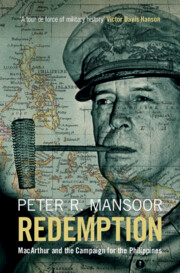Book contents
- Redemption
- Reviews
- Redemption
- Copyright page
- Dedication
- Contents
- Preface
- Note on the Text
- Additional material
- 1 Catastrophe
- 2 The Long Road Back
- 3 The Resistance
- 4 The Decision
- 5 Leyte Gulf
- 6 The Battle for Leyte
- 7 The Invasion of Luzon
- 8 The Battle of Manila
- 9 Clearing Luzon
- 10 The Central and Southern Philippines
- 11 Rebirth
- Acknowledgments
- Figures
- Maps
- Abbreviations
- US Division Nicknames
- Note on Sources
- Notes
- Index
4 - The Decision
Published online by Cambridge University Press: 14 August 2025
- Redemption
- Reviews
- Redemption
- Copyright page
- Dedication
- Contents
- Preface
- Note on the Text
- Additional material
- 1 Catastrophe
- 2 The Long Road Back
- 3 The Resistance
- 4 The Decision
- 5 Leyte Gulf
- 6 The Battle for Leyte
- 7 The Invasion of Luzon
- 8 The Battle of Manila
- 9 Clearing Luzon
- 10 The Central and Southern Philippines
- 11 Rebirth
- Acknowledgments
- Figures
- Maps
- Abbreviations
- US Division Nicknames
- Note on Sources
- Notes
- Index
Summary
MacArthur desired to liberate the Philippines, but the issue would be decided by the Joint Chiefs of Staff in Washington. Forces under Admiral Chester W. Nimitz conducted a drive in the Central Pacific that by the summer of 1944 culminated with the seizure of the strategically crucial Mariana Islands. By that time, MacArthur’s forces had taken key points along the northern coast of New Guinea and had conquered the Admiralty Islands, isolating the major Japanese air and naval base at Rabaul. The question for the JCS was what to do once these operations concluded. The major objective would be bounded by Luzon, Formosa, and the China coast, with an invasion of Formosa initially seen as key to the defeat of Japan. MacArthur naturally viewed Luzon as the primary objective, while Admiral Ernest King in Washington and Admiral Nimitz in Hawaii looked towards Formosa. This disparity set off a storm of messages, planning, and controversy from March through September 1944 until the JCS finally decided the issue by deferring the invasion of Formosa and agreeing to allow MacArthur to liberate both Leyte and Luzon and the capital city, Manila.
Information
- Type
- Chapter
- Information
- RedemptionMacArthur and the Campaign for the Philippines, pp. 147 - 173Publisher: Cambridge University PressPrint publication year: 2025
Accessibility standard: WCAG 2.1 AA
Why this information is here
This section outlines the accessibility features of this content - including support for screen readers, full keyboard navigation and high-contrast display options. This may not be relevant for you.Accessibility Information
Content Navigation
Allows you to navigate directly to chapters, sections, or non‐text items through a linked table of contents, reducing the need for extensive scrolling.
Reading Order & Textual Equivalents
You will encounter all content (including footnotes, captions, etc.) in a clear, sequential flow, making it easier to follow with assistive tools like screen readers.
You get concise descriptions (for images, charts, or media clips), ensuring you do not miss crucial information when visual or audio elements are not accessible.
You get more than just short alt text: you have comprehensive text equivalents, transcripts, captions, or audio descriptions for substantial non‐text content, which is especially helpful for complex visuals or multimedia.
Visual Accessibility
You will still understand key ideas or prompts without relying solely on colour, which is especially helpful if you have colour vision deficiencies.
Structural and Technical Features
You gain clarity from ARIA (Accessible Rich Internet Applications) roles and attributes, as they help assistive technologies interpret how each part of the content functions.
